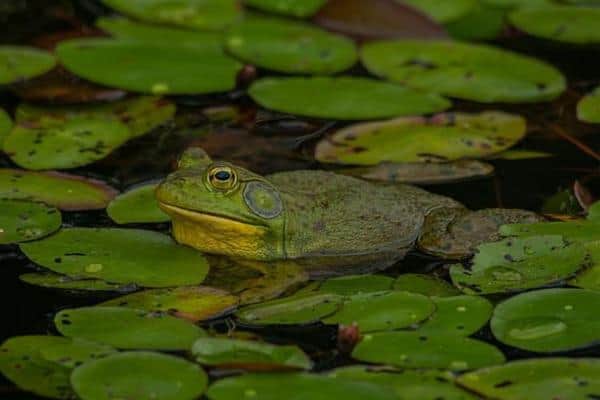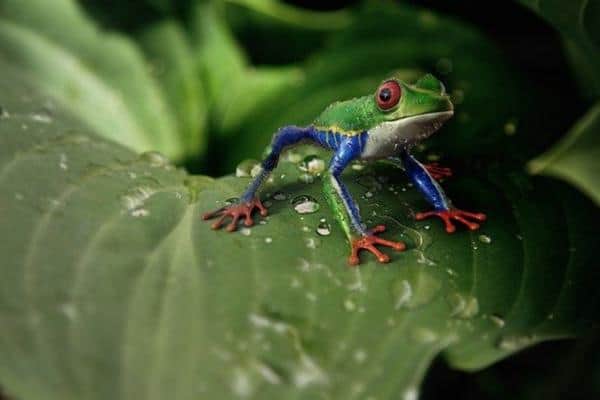Frogs are carnivores, and they will hunt moving prey. They will frequently sit and wait for prey to wander by, but they can also swim after their food. Many types of frogs eat fish, even though these amphibians are frequently depicted as eating flies or other insects. There are some types of frogs that are more likely to be found eating fish than others.
Frogs That Eat Fish
Here are some examples of frogs that eat fish.
1. Northern Pacific Tree Frog

- Scientific name: Pseudacris regilla
- Color: Green
- Size: less than one inch
The Northern Pacific tree frog is a smaller frog, but it can frequently be seen eating fish from ponds and lakes. These frogs use sticky toes to climb trees and stick to branches, but they will also spend time in the water.
They prefer to stay in wet areas, especially regions that see frequent rainfall. While usually green, these types of tree frogs can also be brown or grey. They also have a recognizable black stripe running across their eye.
2. American Bullfrog

- Scientific name: Lithobates catesbeianus
- Color: brown/grey/green
- Size: up to 8 inches
American bullfrogs are one of the largest types of frogs found in North America, often reaching eight inches big. These amphibians are often just referred to as bullfrogs and can weigh up to one pound.
This large type of frog will commonly eat fish small enough to fit in its mouth. Some adult bullfrogs have even been known to eat small mice or snakes. The American bullfrog is most recognized for the deep “ribbit” sound that they make.
3. Northern Leopard Frog

- Scientific name: Lithobates pipiens
- Color: green with speckles
- Size: around 4 inches
The Northern Leopard frog is another frog that commonly feeds on fish. These frogs can be easily spotted by the speckled patterning across their bodies. This type of frog has been commonly used for dissection in schools, which is what makes the northern leopard frog so easily identifiable.
They prefer to live in wet areas, near ponds, creeks, or lakes, where they will frequently prey on small fish. During the winter, they will burrow at the bottom of ponds to survive the weather.
4. Wood Frog

- Scientific name: Lithobates sylvaticus
- Color: brown/tan
- Size: 1-3 inches
Wood frogs can thrive in the cold climates of places like Alaska and Canada, thanks to an adaptation that allows them to survive being completely frozen. These frogs can be found across the Great Lakes, where they will actively hunt small fish.
Wood frogs vary in color, but are commonly brown or tan. They also have recognizable black marks across their face, which resemble a mask.
5. Mink Frog

- Scientific name: Lithobates septentrionalis
- Color: greenish brown
- Size: 2-3 inches
Mink frogs are the frogs commonly associated with lily pads, because of the time these amphibians like to spend around these aquatic plants. They can be found on top of and under lily pads in ponds. Mink frogs are also known for the foul odor they can give off, which works to deter predators.
The odor resembles a mink, which the frog is named for. These frogs will also use surrounding lily pads as a way to escape predators. Due to all the time the mink frog spends in the water, small fish have become a staple part of their diet.
6. Pickerel Frog

- Scientific name: Lithobates palustris
- Color: green with dark markings
- Size: an inch
Pickerel frogs are unique frogs found in North America. These spotted frogs are known for having dark shapes along their bodies, which are typically square-shaped. These markings are seen in two columns along the frog’s back and are the most distinguishing feature that they have.
Pickerel frogs are found along the eastern side of America and Canada. While mistaken for the leopard frog, the pickerel frogs have an orangish belly. As adults, these frogs will feed on small fish, as well as tadpoles, dragonflies, and mosquitos.
7. Spring Peeper

- Scientific name: Pseudacris crucifer
- Color: orange/tan
- Size: one inch
Spring peepers are a common North American frog, but they are typically heard overseen. These frogs start to make their trademark peep noise when spring comes around.
Adults grow to be less than an inch big, and they frequently hide in debris and leaf litter. Despite how common they are, they are hard to actually find. Spring peepers thrive near the edges of lakes and have been known to eat small fish. The markings found on their backs resemble X marks, and their bodies are typically a light orange or tan color.
8. Red-Eyed Tree Frog

- Scientific name: Agalychnis callidryas
- Color: green with blue stripes
- Size: 2-3 inches
Plenty of tropical frogs also feed on fish, including the red-eyed tree frog. This is one of the most easily recognizable tree frogs because of the large red eyes they are named for.
Their webbed feet make it easy to jump from tree to tree, and they can jump further than many other frog species. Since these amphibians are commonly found in rainforests and other wet habitats, they have made fish a frequent part of their diet.
Other Parts of Frog Diets
Frogs are carnivores, and while they will regularly eat fish when given the chance, they have plenty of other prey they will go after. Not only will they eat nearly any insect seen wandering by, but some larger types of frogs have also been known to eat small snakes and even mice or birds. Of course, most frog species are too small for that.
Parts of a frog diet other than fish can include;
- Dragonflies
- Mosquitoes
- Moths
- Grasshoppers
- Crickets
Frogs have even been known to eat tadpoles, and frogs that are smaller than them.
Conclusion
There are multiple types of frogs out there that will eat fish because frogs are carnivorous amphibians. They need to sense movement in order to identify food, and they are quick to attack.
Frogs are able to use their tongues to catch most prey but may need to swim and use their legs to hunt fish. While larger frogs are known for eating fish, there are plenty of smaller frog species that feed on fish too.



